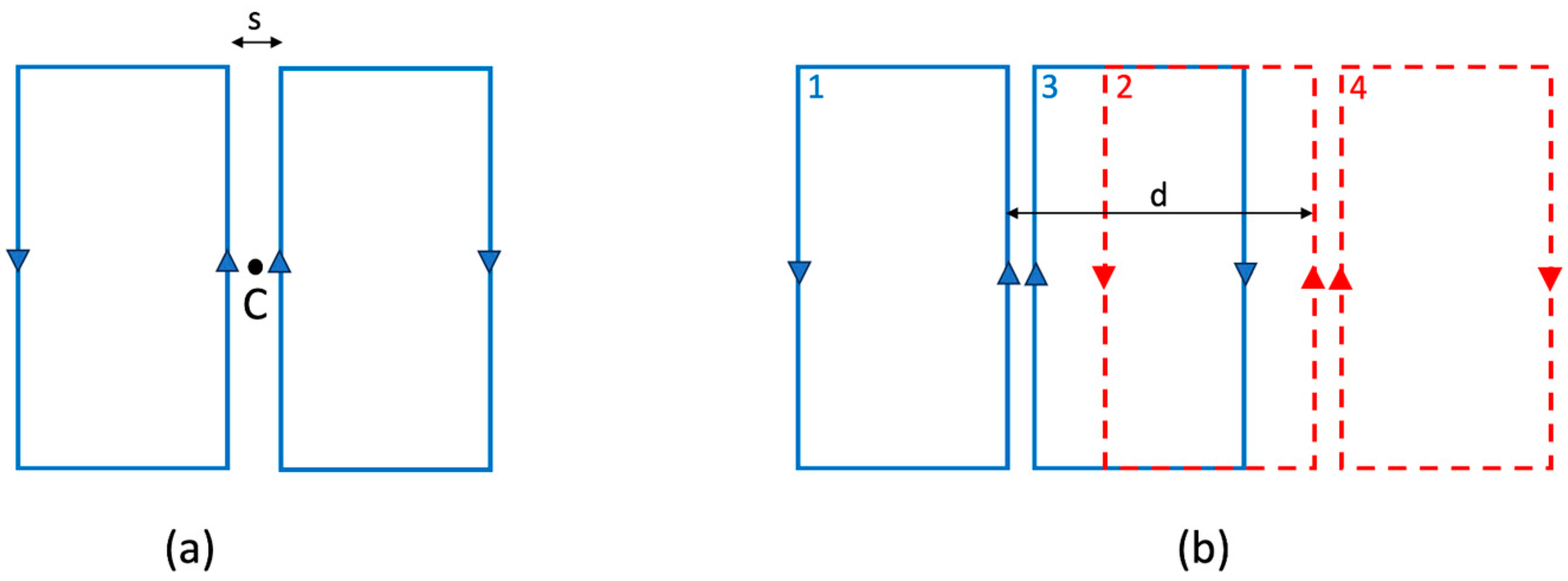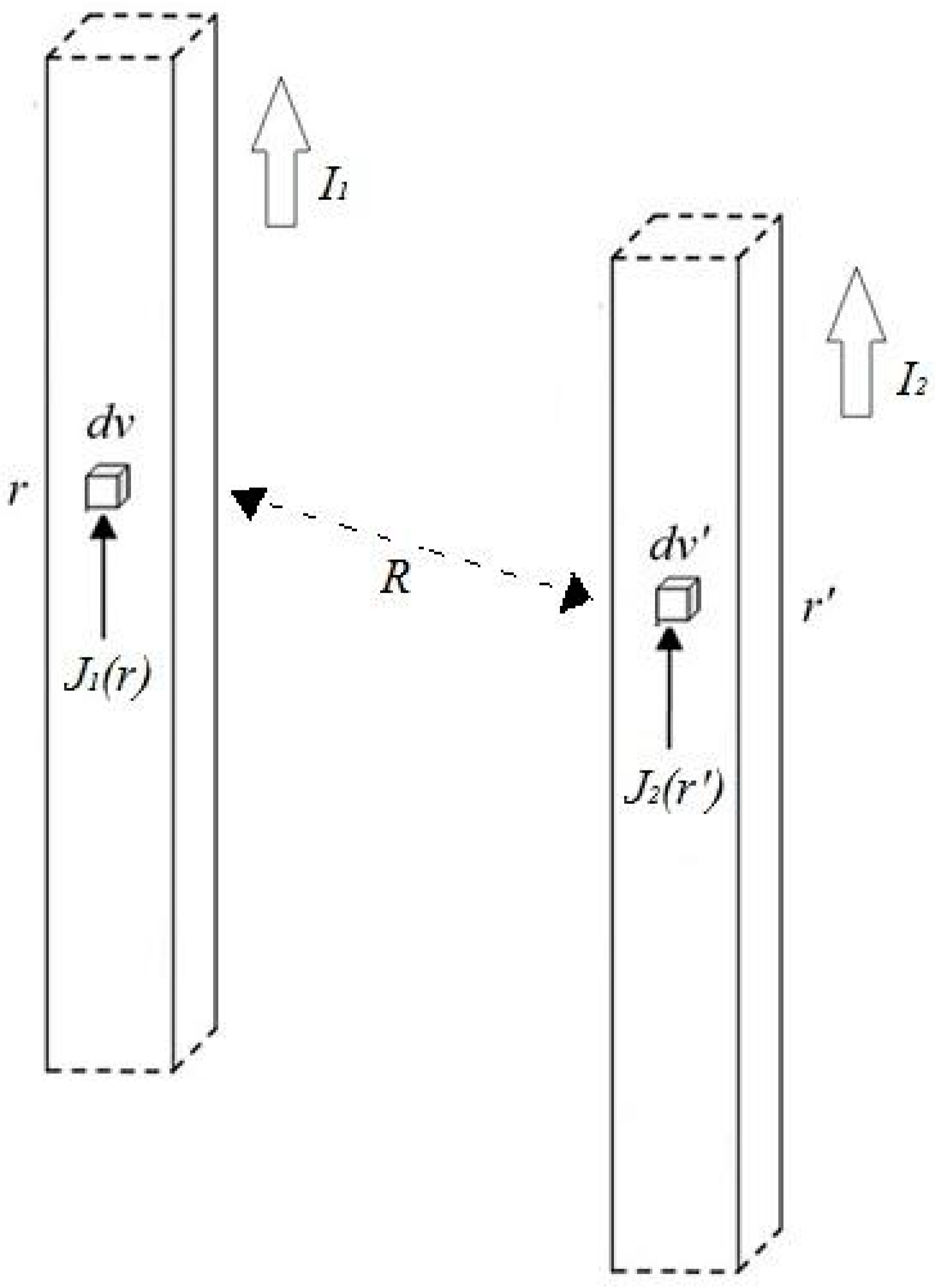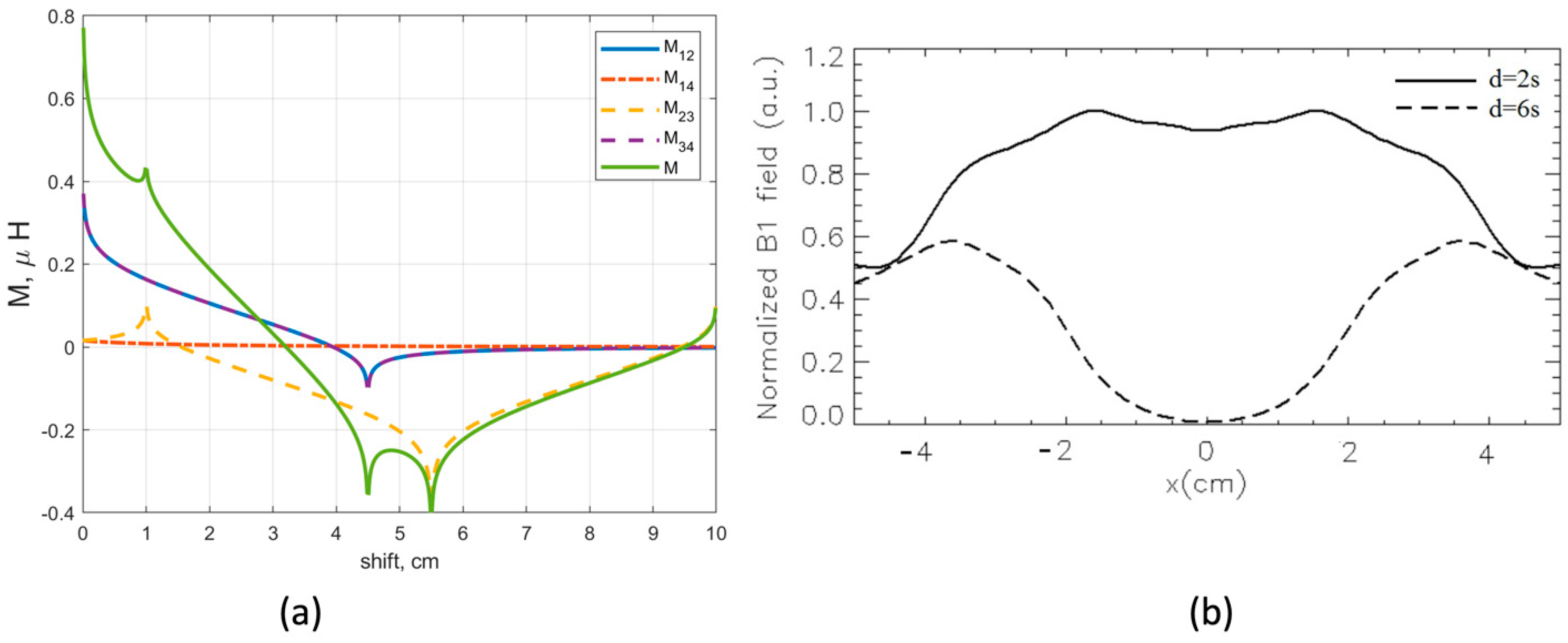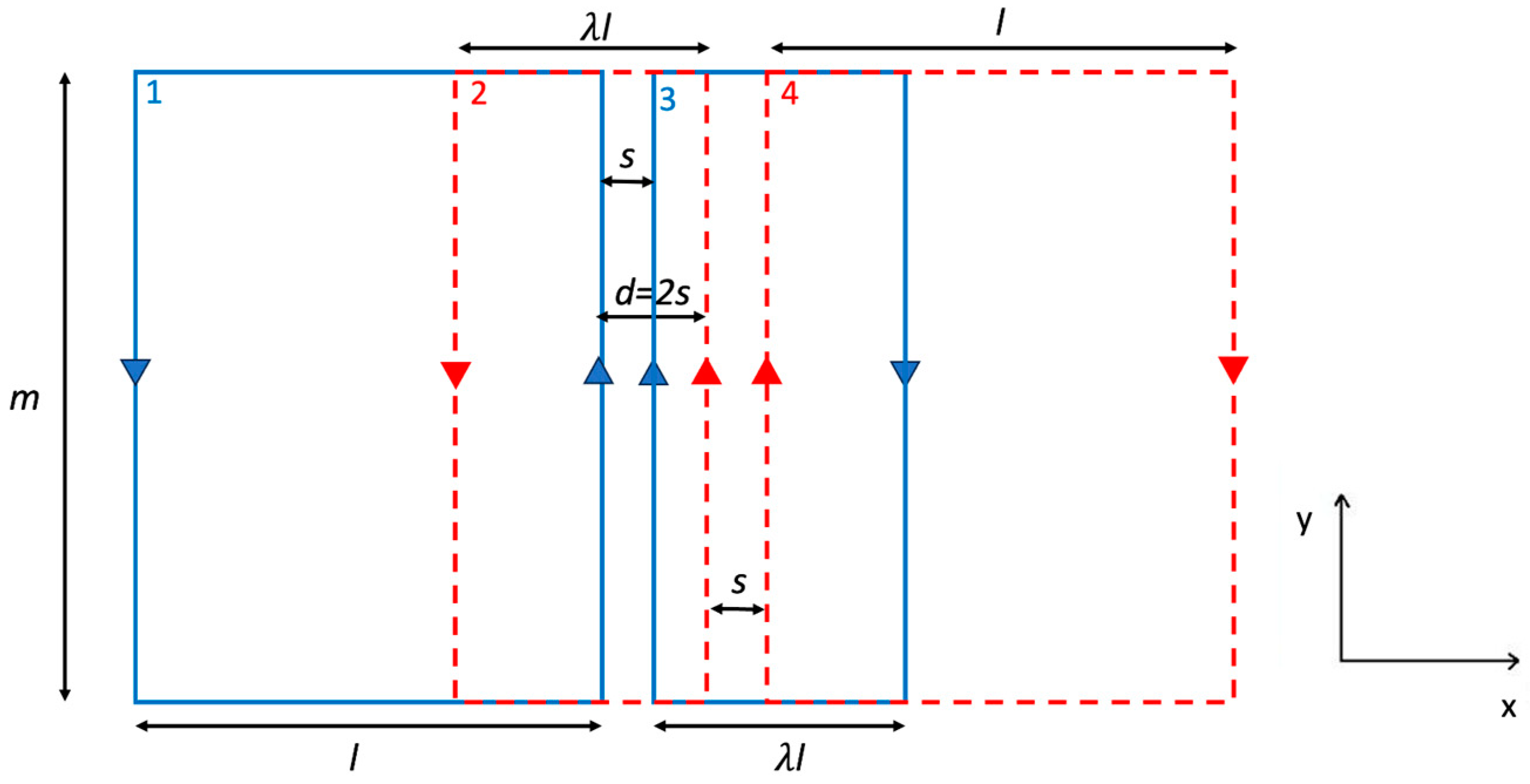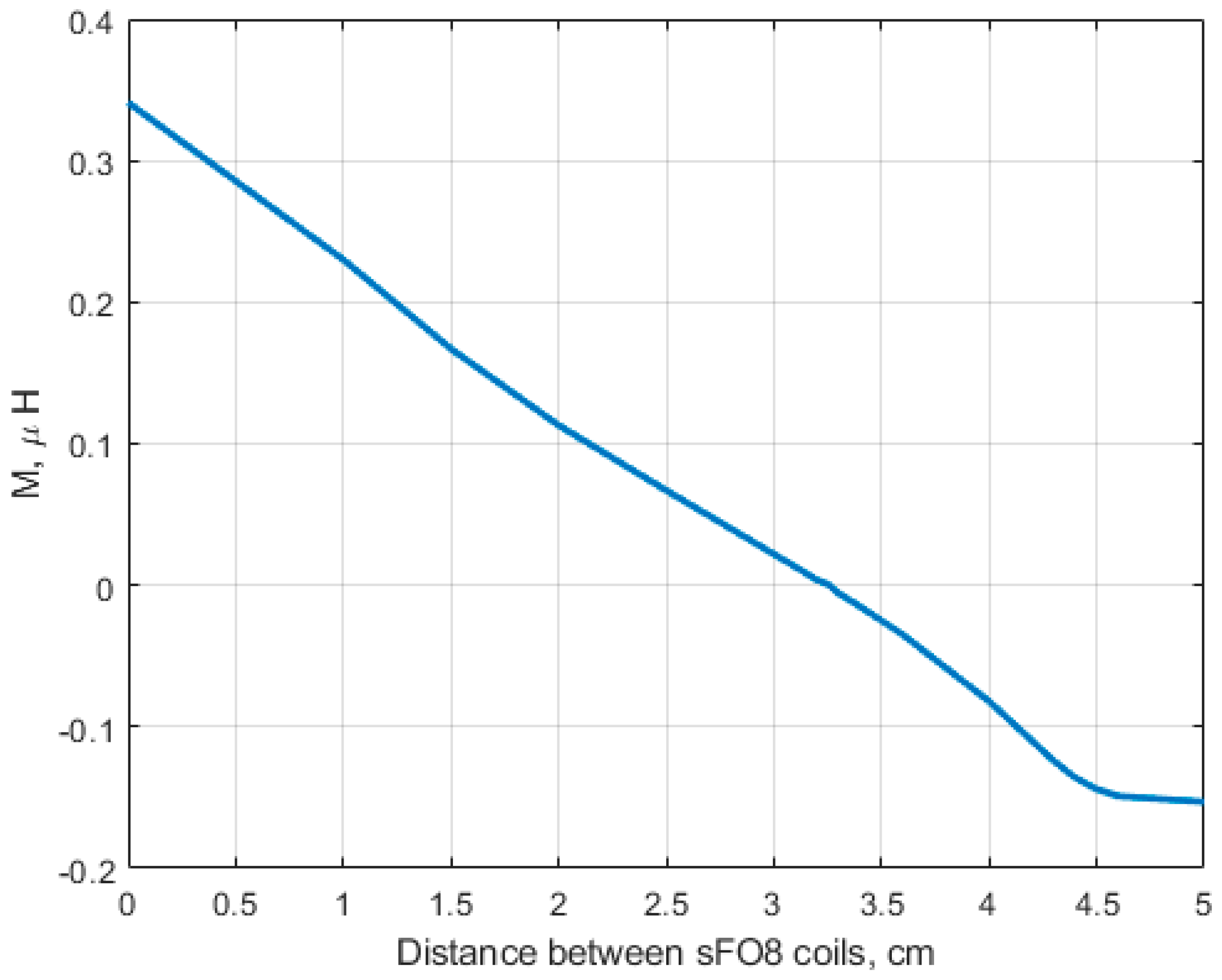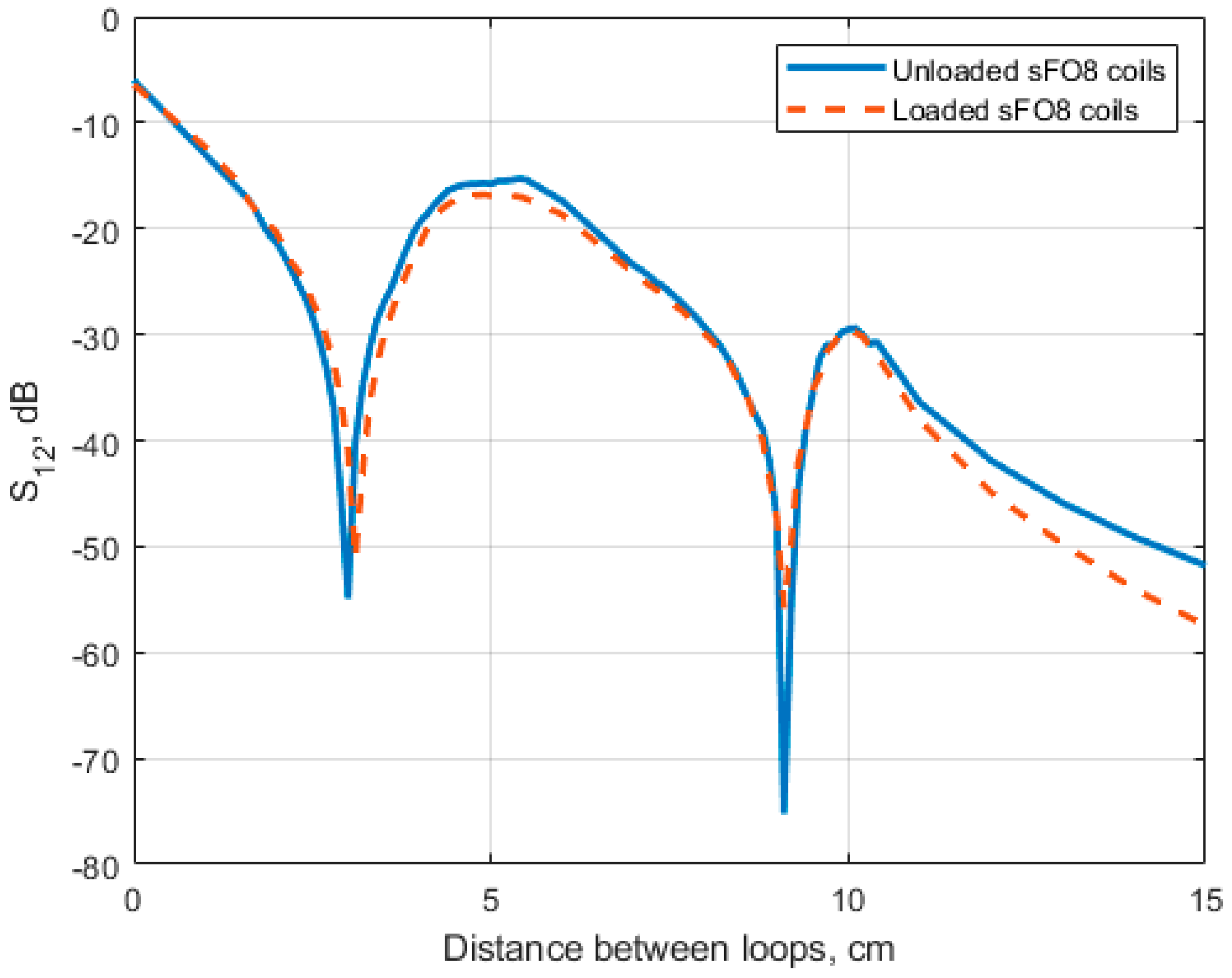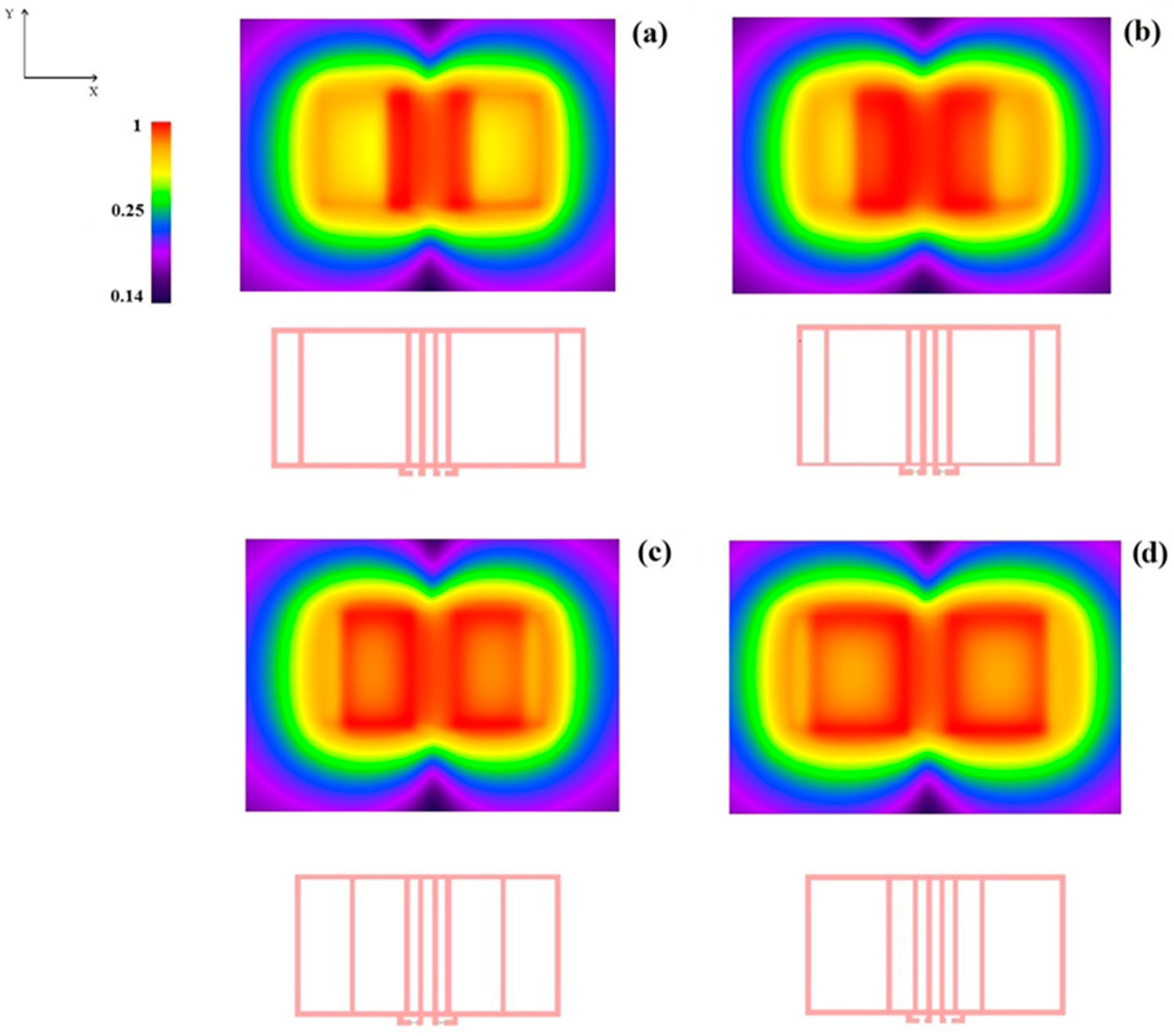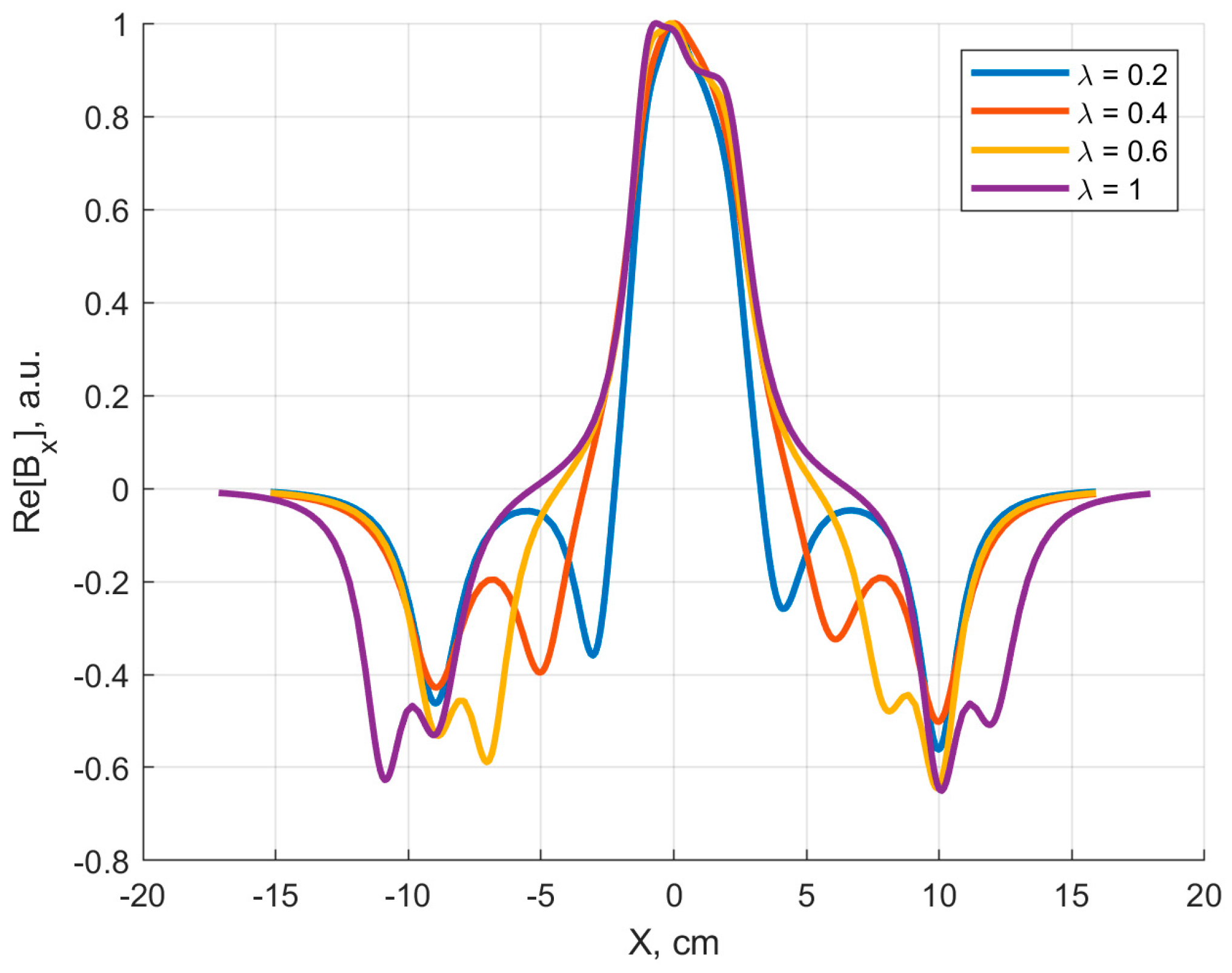1. Introduction
Magnetic Resonance Imaging (MRI) radiofrequency (RF) surface coils may be classified by the nature of their RF magnetic field within a given Region Of Interest (ROI): RF coils with a primarily axial field (i.e., orthogonal to the coil’s surface) and RF coils with a primarily transverse field (i.e., parallel to the coil’s surface) [
1]. The main differences between them are the compromise between Signal-to-Noise Ratio (SNR), field homogeneity, and constraints to their use, depending on the sample shape and static magnetic field orientation.
Transverse RF coils typically show high SNR in a small ROI, while axial RF coils boast higher homogeneity in a larger ROI [
2]. There are exceptions, however, mainly in the realm of metasurfaces for MRI, which show higher SNR than traditional phased-arrays RF coils with the drawback of reduced Field of View (FOV) [
3]. Transverse RF coils are adopted for niche applications, albeit being highly customizable in terms of sensitivity profiles and spatial selectivity [
4].
Figure-of-eight (FO8) or “butterfly” type RF coils are composed, as the name implies, of a single conductor in the shape of a number eight (Lemniscate of Bernoulli) with two straight intersecting elements [
4,
5]. Apart from the high SNR in a restricted ROI, these RF coils can lie below, above, or on the sample’s side for both solenoidal and transverse B0 field MR systems, configurations often not available for standard loop coils. This geometry generates a transverse magnetic RF field in the region above (and below) these central current paths, where the RF coil’s FOV is located. The remaining electrical paths, needed to connect the straight elements along them and to the RF port, are far away from the FOV region, thus providing a negligible contribution to the RF field. In a rectangular FO8 (rFO8) variant, which maintains the same topology and upon which we will focus, the crossing point is displaced laterally and the central elements are parallel and non-crossing. Within the limits imposed by the wavelength of the RF field and the total RF coil electrical length, the central current paths can be made as long as necessary together with the FOV along that direction. At the same time, the distance among these paths cannot be increased above a few centimeters to avoid (i) a highly inhomogeneous sensitivity profile along this direction close to the coil’s plane and (ii) a poor sensitivity at larger depths. This generally limits the sensitivity extension of such RF coils along the RF magnetic field (
) direction. A possible solution to this drawback is to add at least a second identical RF coil, shifted along the
direction, to increase the extent of the sensitivity region.
In the past, transverse RF coils have been proposed as a single-channel detection element [
6], or in combination with (i) an axial coil [
7] or (ii) another coplanar transverse coil rotated by 90° degrees [
8], to form a two-channel system where the two RF coils are geometrically decoupled and the respective RF fields are orthogonal to each other in the ROI, providing a circularly polarized
field that decreases transmit RF power demands and increases SNR [
5].
In this work, we designed a novel two-channel setup made by having two transverse field RF coils with the same spatial orientation. We also considered geometrically asymmetric transverse RF coils, each composed by squared loops of different size. The numerical study at 64 MHz (
1H, 1.5 T) allowed us to minimize the mutual inductance (i.e., optimize decoupling), paving the way for effective FOV enhancement and providing a theoretical framework for the development of optimized dual-channel transverse field RF coil configurations. In
Section 2, we present a theoretical model of mutual coupling among transverse RF coils as well as introduce methods to calculate coil’s mutual inductance using a magnetostatic approach and the
scattering parameter by full-wave simulation. In
Section 3, we present the results obtained by the three methods. In
Section 4, we discuss the results. Our conclusions are reported in
Section 5.
2. Materials and Methods
We will focus on the rectangular FO8 (rFO8) type of coil with parallel central current elements, which can be approximated as composed by two rectangular loops with counter-rotating currents (
Figure 1a). When moving away from the central point between the coil’s center (point C in
Figure 1a) along a direction orthogonal to the coil’s plane, the sensitivity profile generated by current paths reaches a maximum at a depth that is a function of their distance s. This design approximates a real rFO8 coil, which neglects the port and the connection element between the two loops.
The first two approaches will be based on the magnetostatic limit and focused on the calculation of the geometrical mutual inductance among two rFO8 coils (
Figure 1b). This is appropriate when the RF wavelength is much higher than the electric length of the coil [
9], and such a limitation should be kept in mind when realizing coils for specific applications. The first approach will use the thin-wire approximation. The second approach assumes strip conductors with negligible thickness. The third one is based on full wave simulation of the rFO8 coil, realized with strip conductors and complete with all electrical connections. The latter will consider all the physical effects and provide an evaluation of the scattering parameters including the effect of load.
In the following text, we will always consider pairs of rFO8 coils with the same spacing
and use the central current elements to define the relative shift
(
Figure 1b). This allows an easy generalization to the case of rFO8 constituted by two loops of different size along the horizontal direction.
The results for squared loop coils will give qualitative insights valid also for the circular loop transverse coils, thus providing a general framework for understanding the coupling among two transverse coils in general.
2.1. Analytical Calculation of Mutual Inductance
From the classical paper [
10], it is known that for two identical square RF coils it is possible to find the optimal shift between them (equal to 0.9 D, where D is the side of the square) to null their mutual inductance. Coil coupling is mediated both by magnetic and electric fields, but the former is generally the dominant term for MRI applications at low fields (≤1.5 T), and we will focus on it in this study [
11]. Within this approximation, zero mutual inductance between two rFO8 coils allows for independent channels operation, crucial for parallel MRI techniques [
12], and this condition avoids frequency splitting of the resonant coils.
To calculate the mutual inductance of two rFO8 coils, we start from the analytical expression for the mutual inductance [
13] of two coplanar rectangular current loops of equal height positioned on a plane, as shown in
Figure 2:
where μ
0 =
Henry per meter (H/m) is the free space permeability,
and
In the above expressions, the dimensions and relative positions of the RF coils are as from
Figure 2 with
;
is positive (non-overlapping) or negative (overlapping); and infinitely thin wires are assumed.
From Faraday’s law of induction, it is evident that the mutual inductance M is positive and has a maximum when the two squares overlap (), becomes zero for some negative value, has a minimum (with negative value) for , and then approaches zero asymptotically from below as goes to infinity.
We can approximate an rFO8 coil as two squared loops, one with current flowing clockwise and one counterclockwise (see
Figure 1a), using the superposition principle for the calculation of mutual inductance among a pair of rFO8 coils. We chose odd numbers (1, 3) to index the loops belonging to the leftmost rFO8 coil and even numbers (2, 4) to index the loops of the rightmost one (
Figure 1b). Expression (1) can be used to compute the mutual inductance
(i ≠ j) among loop pairs belonging to different rFO8 coils, and the mutual inductance among the two rFO8 coils can be written as follows:
where the sign is positive for pairs of loops with current circulating in the same direction and negative for pairs of loops with current circulating in opposite directions. For identical rFO8 coils in the aforementioned configuration, the following statements are true: (i)
; (ii)
can be positive or negative, depending on the loops’ size and relative position; (iii)
is always negative because loops 1 and 4 are always not overlapping for positive shifts.
Numerical calculations for the computation of Expressions (1) and (2) were carried out using custom code developed in MATLAB (The Mathwork Inc., Natick, MA, USA), provided as open-source software (see the
Supplementary Section).
2.2. Magnetostatic Simulation of the RF Coils
The analytical approach introduced in the previous section has two limitations: (i) the thin wire approximation and (ii) the two coils belonging to the same plane, a non-realistic condition for practical MRI applications. Indeed, surface RF coils are commonly made with strip conductors printed on a dielectric substrate [
14], which forces the second RF coil on a different plane. To consider the effect of conductors with non-zero dimensions, we performed mutual inductance calculations for strip conductors of negligible thickness. The simulations are implemented in IDL 6.0 (Interactive Data Language, Visual Information Solutions, Boulder, CO, USA).
The mutual inductance between two conductors carrying uniform current densities
and
in the volumes V
1 and V
2 can be estimated with the following expression [
15]:
where
and
represent the total currents in volumes V
1 and V
2, respectively, and R = |r-r′| (
Figure 3).
The mutual inductance between two rFO8 coils, each represented with a couple of identical rectangular loops laying on parallel planes with the distance between them equal to h (
Figure 4), can be calculated with Equation (3) by considering the direction of the currents flowing in the conductors.
2.3. FDTD Simulations
Full-wave simulations were performed with the Finite-Difference Time-Domain (FDTD) method using the commercially available software XFdtd 7.8 (Remcom, State College, PA, USA), which allows the simulation of RF coils with arbitrary geometries. We included a phantom simulating a biological tissue, allowing to estimate the effect of load on the decoupling values between the two channels [
16]. In this work, all RF coil elements were designed using the geometry workspace of the XFdtd tool. The simulated rFO8 RF coils were constituted by a Perfect Electric Conductor (PEC) with 4 mm width strips (
Figure 5). The simulations were performed at 64 MHz (
1H, 1.5 T).
In the two-channel RF coil assembly, each coil has a 50 Ω RF port inserted through a 4 mm opening into the rightmost coil. The response to a 64 MHz sinusoidal waveform of amplitude 1A on the first port was used to determine the S
12 scattering parameter in the absence of any tuning device. The non-resonant nature of the simulated RF coils, as well as the use of PEC instead of copper, prevents an accurate calculation of electric coupling but allows us to compute the magnetic coupling, which is the dominant term at the selected working frequency [
11]. The relative distance d between the two rFO8 RF coils was adjusted in 1 mm steps, while the distance h between the two planes was fixed at 2 mm and the linear elements separation s was 1 cm.
The simulations were performed both in unloaded and loaded conditions, the latter with a parallelepiped homogeneous phantom (27.5 × 12.5 × 5 cm) whose dielectric properties met the ASTM (American Society for Testing and Material) criteria for MR phantom at 1.5 T (electrical conductivity
= 0.6 S/m, permittivity
= 80 F/m) [
17]. Successively, the magnetic field B
1 distribution was estimated by feeding a 64 MHz (1A amplitude) sinusoidal input to both coils’ ports.
4. Discussion
From the previous sections, we provide evidence that two planar identical rFO8 RF coils can be fully decoupled when the central linear elements of the two coils are properly shifted with respect to each other, a condition that depends on the details of the coils’ geometry. This resembles a similar property of axial-field RF coils, widely used to decouple the nearest neighboring elements in a classical RF phased-array configuration.
Results from the analytical model (
Figure 6 and
Figure 8) are in reasonable quantitative agreement with both the magnetostatic calculations performed assuming strip-like conductors (
Figure 9) and the full-wave FDTD simulations, obtained with or without a loading sample having electrical parameters equivalent to muscle tissue at 64 MHz (
Figure 10).
Our first main result is the evidence of two different mutual shifts that decouple a two-channel setup made by two identical and symmetric rFO8 coils. The analytical model allows us to obtain some insights for both situations. The first one is that the
contribution is always negligible due to the distance between the respective loops. For the smaller shift, we have a cancellation among the
contributions and the
one, with opposite signs. For the larger shift,
because the corresponding loops are well separated, while
because of critical overlap among loops 2 and 3 (see
Figure 1b).
We conclude that the analytical model is a useful tool for the initial physical understanding of the RF coil design and the optimization steps required for a full design of the dual-channel rFO8 configuration at 64 MHz. For these reasons, we freely provide the custom-made MATLAB code for the calculation of the mutual inductance: it can be used and easily adapted by other groups to optimize the RF coils’ geometry according to their specific applications.
The zero mutual inductance condition guarantees zero (magnetic) coupling among the two RF channels. However, the geometrical constraints it introduces (i.e., the shift value that realizes such condition, ), can be unfit to the transverse-axis FOV target applications. This could be the case when , a condition that is associated with a sensitivity void along the transverse-axis direction.
We explored, for the first time, a possible geometrical modification of the rFO8 RF coil used in the two-channel setup, with the aim to reduce the decoupling shift, thus avoiding the RF sensitivity void. This can be achieved by properly positioning the return linear current paths of each rFO8 RF coil (i.e., the ones that are away from the central area close to the coil’s FOV). Among all possibilities, we considered the simplest one, introducing the asymmetry parameter
that changes the size, along the transverse-direction, of one of the two loops that constitute each rFO8 RF coil (
Figure 7). To stick closer to a practical realization of the proposed setup for 1.5 T MRI, we decided to consider two identical rFO8 RF coils with a clear advantage: the same design and tuning/matching capacitors can be used. The analytical model showed that the condition
can indeed significantly reduce the shift value
(
Figure 8a); further, if needed, it can be used to reduce the rFO8 coils’ shift.
We finally focused on the two-channel setup made by two rFO8 RF coils with
, which, compared to the single rFO8 case, should guarantee an almost doubled FOV with no voids in the RF field sensitivity profile. In this case, we changed strategy, shifting away from the
condition, which previous results showed not to be attainable for the considered geometries. Here, we aimed to modify the coils’ geometry to minimize coupling. In practice, this means that
should be less than
dB:
dB is commonly considered an acceptable inter-channel isolation level by the MRI practitioners, keeping in mind that additional preamplifier decoupling techniques [
10,
19] are typically applied.
The analytical model confirms that, by properly adjusting
, the total mutual inductance
may be reduced (
Figure 8b). To translate this result in terms of
, it is important to note that the
value was reduced more than the self inductance
, i.e., the magnetic coupling coefficient
was effectively reduced. This was confirmed by the magnetostatic simulations (see
Table 1) and the final proof comes from the full-wave FDTD simulations reported in
Table 2, showing that the S
12 parameter improves from about −19 dB to −28 dB as
varies from 1.0 to 0.2.
From the full-wave FDTD results obtained for symmetric rFO8 RF coils (
Figure 10) we notice that S
12 < −15 dB is satisfied for all shift values
cm. This suggests that, within the considered geometry, a two-channel setup configuration seems feasible from the point of view of coils’ decoupling even for
. However, is worth noting that transverse field RF coils present return current paths with opposite current, as compared to the central conductive elements. In a multiple elements array configuration, the magnetic field contribution from the return paths will inevitably spoil the RF
homogeneity in the central FOV, unless very large
values are considered for the building block RF loops. We conclude that a careful quantitative analysis of multiple-channel RF array configurations’ RF magnetic field profiles is necessary before stating their practical feasibility.
The use of multiple independent MRI receivers is adopted to enlarge the FOV and/or to allow parallel MRI for signal acquisition acceleration [
5]. In both cases, the RF magnetic field sensitivity profiles of each RF coil element in the array should ideally have some degree of overlap to guarantee a relatively uniform coverage of the extended FOV. The results presented in
Figure 11 demonstrate that this can be reasonably achieved with two rFO8 RF coils. A quantitative analysis of the RF
homogeneity for the proposed setups is beyond the scope of this work since our focus was to prove the feasibility of RF coils’ decoupling.
Symmetric FO8 RF coils can operate in conjunction with (axial) loop RF coils. Such configurations can be designed to exploit geometrical decoupling (when the two coils have coincident centers) and quadrature operation. This is possible because both FO8 and loop coils have a symmetry plane parallel to the y axis but with opposite parity of the magnetic field along the x axis: decoupling is realized when such planes coincide. When a two-channel transverse field RF coil (both symmetric and asymmetric) is considered, a symmetry plane still exists for the total magnetic field, but it does not coincide with the symmetry plane of each rFO8 coil. We conclude that two rFO8 RF coils on a row can be decoupled but this prevents the geometrical decoupling with overlapping (axial) loop coils.
5. Conclusions
In this work, we proposed a two-channel transverse field RF coil setup that provides an extended FOV compared to the single-channel RF coil. The individual RF coils were designed to minimize the mutual coupling between the channels, also considering a specific geometric arrangement that should guarantee a good magnetic field homogeneity.
It represents a novelty since the use of transverse field RF coils in MRI was traditionally limited to a single element. When dual-channel setups were proposed, they consisted of either (i) an FO8 coil and a loop (axial) coil or (ii) two orthogonal FO8 coils. In both cases, the two coils were geometrically decoupled and, with orthogonal fields, used purposely to generate a circularly polarized field.
Our results are based on rectangular FO8 coils, but we expect the qualitative picture to remain valid if we consider different kinds of FO8 coils: (i) coils with semicircular shape return currents; (ii) FO8 with non-parallel but crossing central current elements and squared as well as semicircular return paths.
In our approach, a zero mutual inductance condition can be naturally realized, and, within some limitations, it can be tuned using the proposed asymmetry in the rFO8 RF coils’ design. This opens the possibility to consider array-like configurations of multiple rFO8 RF coils, where the nearest neighboring elements can be decoupled and the next-to-nearest ones could have small enough coupling to be operated directly or with the help of other decoupling methods (like preamplifier decoupling for receiver-only configurations). This could allow parallel MRI and signal acquisition acceleration in the future.
